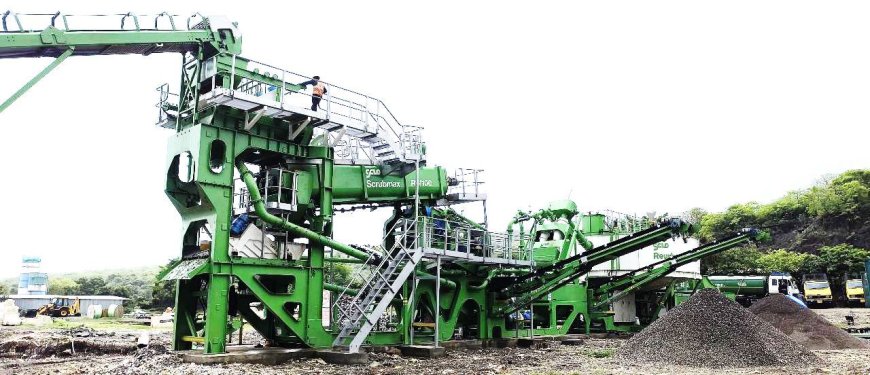India is undergoing rapid urbanization, with cities expanding to accommodate a growing population. This urban growth has led to a boom in construction activities, resulting in a significant increase in construction and demolition (C&D) waste. According to estimates, India generates around 150 million tons of C&D waste annually, which is estimated to be 35-40% of the global C&D waste. Only a small fraction of it is processed or recycled. The mismanagement of construction waste in urban areas has severe environmental consequences, but recycling can provide numerous benefits, promoting sustainability and reducing the environmental footprint.
Impact of construction waste on the environment
Land pollution: Construction waste, including debris from demolished buildings, bricks, concrete, wood, glass, plastics, and metals, is often dumped in open spaces, vacant lands, or unauthorized areas. This uncontrolled disposal reduces the availability of land, leads to land degradation, and creates unsightly dumps that contribute to urban decay. Illegal dumping of waste along the coastal land in the coastal cities damages the marine bio-diversity, making such areas more prone to flooding as a result of climate change.
Air pollution: Dust from construction sites, demolition activities, and improperly disposed of materials contributes to particulate matter (PM2.5 and PM10) pollution in Indian cities, exacerbating air pollution. The burning of wood, plastic, or other waste further releases toxic gases, worsening air quality and leading to respiratory diseases.
Water pollution: Construction waste, when dumped in water bodies, clogs drainage systems and leads to flooding, a common problem in cities like Mumbai and Chennai. The leaching of hazardous substances from waste materials contaminates groundwater and surface water sources, affecting aquatic life and human health.
Climate change contribution: C&D waste contributes to greenhouse gas (GHG) emissions. Cement production, a major component of construction, is a carbon-intensive process. Additionally, when construction waste decomposes, it emits methane, a potent greenhouse gas. Unmanaged waste also increases the need for new raw materials, further depleting natural resources and escalating emissions.
Loss of natural resources: The demand for raw materials like sand, gravel, limestone, and timber leads to excessive resource extraction, deforestation, and damage to river ecosystems. The unchecked mining of sand from riverbeds, for instance, has led to severe ecological imbalances and the destruction of aquatic habitats.
Benefits of recycling construction waste
Delhi was first city to set up the C&D waste recycling facility. Antony Waste Handling Cell Limited has set up a sophisticated C&D waste recycling facility in Mumbai with an installed capacity of processing ~70 tonnes of C&D waste per hour (~700 tonnes per day).
Following are the advantages of C&D waste recycling:
Reduction in landfill waste: Recycling C&D waste reduces the amount of debris dumped in landfills, preserving land for more productive use. Given that urban areas in India are facing a shortage of landfill space, recycling construction materials can mitigate land pollution and extend the lifespan of existing waste disposal sites.
Lower air and water pollution: By processing and reusing materials, recycling minimizes the amount of dust, toxins, and pollutants released into the environment. It prevents harmful leachates from contaminating water bodies and helps maintain cleaner air in cities, improving public health.
Conservation of natural resources: Recycling reduces the need for new raw materials, thereby protecting natural ecosystems. For example, recycled aggregates from demolished concrete can be used in new construction, reducing the demand for sand and gravel. This helps prevent riverbed erosion and forest degradation caused by resource extraction.
Energy savings and lower carbon footprint: Producing new construction materials from raw resources is energy-intensive and results in high carbon emissions. Recycling reduces energy consumption by repurposing existing materials, leading to lower greenhouse gas emissions and helping India meet its climate commitments under the Paris Agreement.
Economic and employment opportunities: Recycling creates new business opportunities in waste management, material recovery, and green construction. The circular economy model, where waste is transformed into valuable resources, promotes entrepreneurship and generates employment in waste collection, sorting, and recycling industries.
Cost reduction in construction
Recycled materials such as reclaimed wood, crushed concrete, and reused steel are often cheaper than new materials. This lowers the overall cost of construction, making buildings more affordable and encouraging sustainable development in urban areas. Infrastructure projects need to set up their own recycling facilities.
Waste management in infrastructure projects: The Construction and Demolition Waste Rules 2016 stipulate that large project should ideally adopt significant in situ utilisation of C&D waste in their projects. In order to comply with these provisions, the agencies involved may have to develop their own recycling facilities. For example, DMRC has done so. Concrete can be easily recycled. Globally, proactive prevention of waste is undertaken through modification of existing on-site construction practices etc.
Use of plastics in road construction
Use of plastics as a partial substitute to bitumen can reduce the construction cost and provide a solution to the non-recyclable plastics. This has been demonstrated in Mumbai and many other road projects. This needs to be documented and scaled up.
Conclusion
Construction waste is a growing environmental problem in India’s urban areas, contributing to land, air, and water pollution while depleting natural resources. However, recycling C&D waste presents a sustainable solution, offering economic, environmental, and social benefits. By adopting efficient waste management policies, investing in recycling infrastructure, and promoting awareness, India can mitigate the environmental damage caused by construction waste and move towards a greener, more sustainable urban future.

Ajit Kumar Jain, IAS (retd)
Chairman and Managing Director, ERAF Environment Research Foundation









